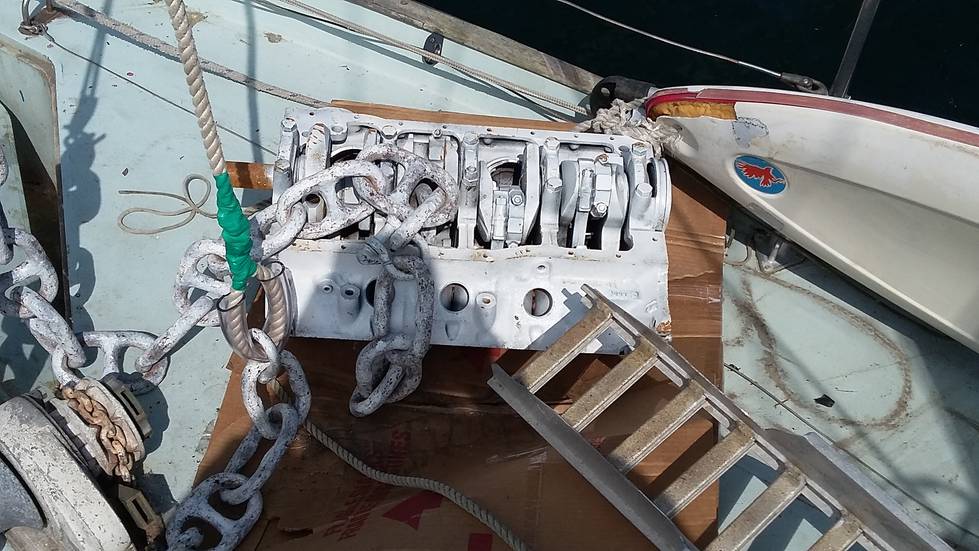
Commonly here people use a 130kg concrete block with re-bar hoops as a mud-weight, giving an effective weight in water of some 85kgf. I'd heard of someone using an engine block and decided to do that instead. It's lighter but denser - 90kg with an effective weight of 75kgf. I got a cast-iron V8 block for $50 and cleaned it off with hot water. I'd salvaged a length of half-inch chain from a nearby beach and ran that through one of the cylinders with a galvanized steel shackle, as below. Then I made an eye-splice in some moderately thick 3-strand I used for the kedge anchor, with some thick poly tubing to protect it from chafe, and attached it with a shackle. As I recall, I'd secured the pin with steel wire, thinking that would not eat through the pin by galvanic action as a copper wire would. I wasn't sure about stainless.

Engine block with chain.

Ready to lower.
I picked a spot roughly equidistant from existing moorings with the same kind of spacing, and lowered it with, I think, the derrick I use to lower my motorcycle onto the "landing craft". Later, I dived on it to pin it with a couple of 4 foot lengths of re-bar, and found the block had worked its way into the mud for almost its full height.
Thus it sat over the winter, until mid-June, when I rowed out to Alastor and initially couldn't find her. Then I noticed her tied up to floating dock about a hundred yards away. She was secured with a jib sheet, and the mooring line. The mooring line was still cleated on the foredeck, the eye splice was intact, but obviously it was no longer secured with the shackle.
I conjecture the shackle pin must have worked loose after the wire broke or corroded through. I suppose that waves pulling on the line might have rhythmically worked the plastic tube against the pin and generated enough friction to unscrew it, given that the shackle was new and not yet rusted in place. A fellow boater had found Alastor adrift and rescued her.
All I had to do, then, was to reattach the mooring line to the chain with a new shackle. First I had to find it. I anchored in place where my GPS waypoint said the mooring was, in 27 feet of water. Visibility was about eight feet, providing I didn't stir the bottom up too much. No way to see the mooring from the surface.
I had about half a tankful of air, about 1800psi. I started off with the idea to take a line and a float with me, to mark the chain when I found it. I had prepared a knotted rope about 30 foot long and secured that to the anchor chain where it reached the bottom, and swam in a circle at the full extent of the rope, finding nothing. I then realized that the extra rope was more trouble than it was worth - I could just use the measuring rope to mark the chain as the other end was at at known location (the anchor chain) and dispense with the float. Ropes underwater are a menace; they get tangled around things, like your feet and air tank.
On a second pass using a third the rope length, swimming in a 20-foot diameter circle rather than a 60-foot one, I found the chain quite close to where I'd anchored. Having already dropped the mooring line over the side, I was able to attach it with a new shackle and tighten it with the wrench I'd clipped to my vest with a loop of rope and a carabiner. By this time I'd basically got no air left so I didn't have a chance to search for the original shackle.
When I surfaced there was someone in a boat saying "I see you've found your boat" - a friend of the person who'd rescued Alastor.
Cross fingers, it won't come loose again, with a couple of cable ties holding the pin in place.
Andrew Daviel, 2019